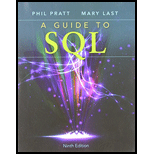
Concept explainers
Explanation of Solution
a.
MONTHS_BETWEEN ():
The function “MONTHS_BETWEEN” is used to return the number of months between dates. If the “date1” is future than “date2”, then the result is positive. If the “date1” is previous than “date2”, then the result is negative.
Syntax:
MONTHS_BETWEEN (DATE1, DATE2)
Example:
Consider an example for the “MONTHS_BETWEEN ()” function in Oracle is as follows:
SELECT MONTHS_BETWEEN (TO_DATE ('11-03-2019', 'MM/DD/YYYY'), TO_DATE ('06-16-2014', 'MM/DD/YYYY')) "Months" FROM DUAL;
Explanation:
The above query is used to display the difference between “11-03-2019” and “06-16-2014” dates.
Difference between “CURRENT_DATE” and “SYSDATE” function:
| “CURRENT_DATE” function | “SYSDATE” function |
| The “CURRENT_DATE” function is used to return the current date. Depending on user input (numeric or string), it will return the current date in “YYYY-MM-DD” OR “YYYYMMDD” format. | The “SYSDATE” function is used to return the current date and time for the |
| The syntax for “CURRENT_DATE” is “CURRENT_DATE ();” | The syntax for “SYSDATE” is “SYSDATE ();” |
Functions in Oracle, SQL Server and Access:
“No”, the “MONTHS_BETWEEN ()” function is not available in SQL Server, and Access, but other functions are present in the Oracle, SQL Server, and Access.
- The “DATEDIFF” function can be used to return the number of months given a starting date and an ending date in the SQL Server.
“MONTHS_BETWEEN ()” in Oracle:
- The function “MONTHS_BETWEEN” is used to return the number of months between dates.
- Syntax is “MONTHS_BETWEEN (DATE1, DATE2)”
- Example is “SELECT MONTHS_BETWEEN (TO_DATE ('11-03-2019', 'MM/DD/YYYY'), TO_DATE ('06-16-2014', 'MM/DD/YYYY')) "Months" FROM DUAL;”...
Explanation of Solution
b.
Difference between “NOW ()” and “DATE ()” function:
| “NOW ()”function | “DATE ()” function |
|
The “NOW ()” function is used to return the current date and time in Access... |
Trending nowThis is a popular solution!

Chapter 8 Solutions
A Guide to SQL
- Outline the overall steps for configuring and securing Linux servers Consider and describe how a mixed Operating System environment will affect what you have to do to protect the company assets Describe at least three technologies that will help to protect CIA of data on Linux systemsarrow_forwardNode.js, Express, Nunjucks, MongoDB, and Mongoose There are a couple of programs similar to this assignment given in the lecture notes for the week that discusses CRUD operations. Specifically, the Admin example and the CIT301 example both have index.js code and nunjucks code similar to this assignment. You may find some of the other example programs useful as well. It would ultimately save you time if you have already studied these programs before giving this assignment a shot. Either way, hopefully you'll start early and you've kept to the schedule in terms of reading the lecture notes. You will need to create a database named travel using compass, then create a collection named trips. Use these names; your code must work with my database. The trips documents should then be imported unto the trips collection by importing the JSON file containing all the data as linked below. The file itself is named trips.json, and is available on the course website in the same folder as this…arrow_forwardusing r languagearrow_forward
- using r languagearrow_forwardusing r languagearrow_forwardWrite a short paper (1 page/about 500 words) summarizing what we as System Admins can do to protect the CIA of our servers. Outline the overall steps for configuring and securing Linux servers Consider and describe how a mixed Operating System environment will affect what you have to do to protect the company assets Describe at least three technologies that will help to protect CIA of data on Linux systems Required Resourcesarrow_forward
- using r language Estimate the MSE of the level k trimmed means for random samples of size 20 generated from a standard Cauchy distribution. (The target parameter θis the center or median; the expected value does not exist.) Summarize the estimates of MSE in a table for k= 1,2,...,9arrow_forwardusing r language Estimate the MSE of the level k trimmed means for random samples of size 20 generated from a standard Cauchy distribution. (The target parameter θis the center or median; the expected value does not exist.) Summarize the estimates of MSE in a table for k= 1,2,...,9arrow_forwardusing r language The data law82 in bootstrap library contains LSAT and GPA for 82 law schools. Compute a 95% bootstrap t confidence interval estimates for the correlation statisticsarrow_forward
- using r language The data law82 in bootstrap library contains LSAT and GPA for 82 law schools. Compute a 95% bootstrap t confidence interval estimates for the correlation statisticsarrow_forwardusing r langauge The data law82 in bootstrap library contains LSAT and GPA for 82 law schools. Compute and compare the three 95% bootstrap confidence interval estimates for the correlation statistics.arrow_forwardWhat is the number of derangements of size k from the set {1,2,...n} to the set {1,2,...n} so that f(x) != x exactly k times with 1 <= k <= narrow_forward
 A Guide to SQLComputer ScienceISBN:9781111527273Author:Philip J. PrattPublisher:Course Technology Ptr
A Guide to SQLComputer ScienceISBN:9781111527273Author:Philip J. PrattPublisher:Course Technology Ptr Database Systems: Design, Implementation, & Manag...Computer ScienceISBN:9781285196145Author:Steven, Steven Morris, Carlos Coronel, Carlos, Coronel, Carlos; Morris, Carlos Coronel and Steven Morris, Carlos Coronel; Steven Morris, Steven Morris; Carlos CoronelPublisher:Cengage Learning
Database Systems: Design, Implementation, & Manag...Computer ScienceISBN:9781285196145Author:Steven, Steven Morris, Carlos Coronel, Carlos, Coronel, Carlos; Morris, Carlos Coronel and Steven Morris, Carlos Coronel; Steven Morris, Steven Morris; Carlos CoronelPublisher:Cengage Learning Database Systems: Design, Implementation, & Manag...Computer ScienceISBN:9781305627482Author:Carlos Coronel, Steven MorrisPublisher:Cengage Learning
Database Systems: Design, Implementation, & Manag...Computer ScienceISBN:9781305627482Author:Carlos Coronel, Steven MorrisPublisher:Cengage Learning



